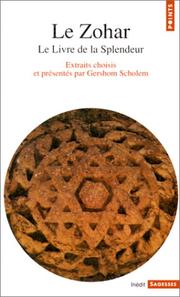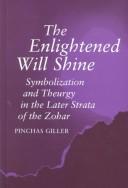| Listing 1 - 10 of 49 | << page >> |
Sort by
|
Book
Year: 1975 Publisher: Jerusalem : Research Center of Kabbalah,
Abstract | Keywords | Export | Availability | Bookmark
 Loading...
Loading...Choose an application
- Reference Manager
- EndNote
- RefWorks (Direct export to RefWorks)
Book
Abstract | Keywords | Export | Availability | Bookmark
 Loading...
Loading...Choose an application
- Reference Manager
- EndNote
- RefWorks (Direct export to RefWorks)
Fonds Suzan Daniel (FSD)
296*42 --- 296*42 Zohar --- Zohar
Book
ISBN: 1438430558 1441648798 9781441648792 1438430531 9781438430539 9781438430553 9781438430539 9781438430553 9781438430546 143843054X Year: 2010 Publisher: Albany, NY State University of New York Press
Abstract | Keywords | Export | Availability | Bookmark
Book
ISBN: 1503628582 Year: 2021 Publisher: Stanford, California : Stanford University Press,
Abstract | Keywords | Export | Availability | Bookmark
 Loading...
Loading...Choose an application
- Reference Manager
- EndNote
- RefWorks (Direct export to RefWorks)
A magisterial, modern reading of the deepest mysteries in the Kabbalistic tradition. 'Seekers of the Face' opens the profound treasure house at the heart of Judaism's most important mystical work: the Idra Rabba (Great Gathering) of the Zohar. This is the story of the Great Assembly of mystics called to order by the master teacher and hero of the Zohar, Rabbi Shim'on bar Yochai, to align the divine faces and to heal Jewish religion. The Idra Rabba demands a radical expansion of the religious worldview, as it reveals God's faces and bodies in daring, anthropomorphic language. Melila Hellner-Eshed makes this challenging, esoteric masterpiece meaningful for everyday readers.
Cabala. --- Idra rabba. --- Zohar.
Book
ISBN: 2850760579 9782850760570 Year: 1978 Publisher: Paris : Dervy-Livres,
Abstract | Keywords | Export | Availability | Bookmark
 Loading...
Loading...Choose an application
- Reference Manager
- EndNote
- RefWorks (Direct export to RefWorks)
Cabala. --- Kabbale --- Zohar. --- Bible. --- Commentaries. --- Cabala --- Zohar --- Bible --- Commentaries
Book
ISBN: 2266149261 9782266149266 Year: 2005 Volume: 286 Publisher: Paris : Pocket,
Abstract | Keywords | Export | Availability | Bookmark
 Loading...
Loading...Choose an application
- Reference Manager
- EndNote
- RefWorks (Direct export to RefWorks)
Mysticism --- Mysticisme --- Judaism --- Judaïsme --- Zohar. --- Judaism. --- Zohar --- Mysticism - Judaism.
Book
ISBN: 9020247417 Year: 1984 Publisher: Deventer Uitgeverij Ankh-Hermes bv
Abstract | Keywords | Export | Availability | Bookmark
 Loading...
Loading...Choose an application
- Reference Manager
- EndNote
- RefWorks (Direct export to RefWorks)
296*42 --- 296*42 Zohar --- Zohar --- Jewish religion

ISBN: 2020054183 9782020054188 9782757818657 Year: 1980 Volume: Sa 21 Publisher: Paris Seuil
Abstract | Keywords | Export | Availability | Bookmark
 Loading...
Loading...Choose an application
- Reference Manager
- EndNote
- RefWorks (Direct export to RefWorks)
Jewish religion --- Cabala. --- Kabbale --- Zohar

ISBN: 1438404093 0585075220 9780585075228 9780791417119 0791417115 9780791417126 0791417123 0791417115 0791417123 9781438404097 Year: 1993 Publisher: Albany State University of New York Press
Abstract | Keywords | Export | Availability | Bookmark
 Loading...
Loading...Choose an application
- Reference Manager
- EndNote
- RefWorks (Direct export to RefWorks)
Theurgy --- Cabala --- Magic --- History. --- Raʻaya mehemana. --- Tikkunei Zohar. --- Sefer Tiḳune ha-Zohar --- Sefer Tiḳune Zohar --- Tikouney Hazohar --- Tiḳune ha-Zohar --- Tiḳune Zohar --- Tiqqunei Zohar --- Zohar. --- Raʾaya Meheimna --- Faithful Shepherd --- Roʻeh ha-neʾeman --- Sefer Raʻaya mehemana --- Kabbale --- History --- Histoire --- Tikkunei Zohar --- Raʻaya mehemana --- Raaya mehemana.
Book
ISBN: 1438479735 9781438479736 1438479719 9781438479712 Year: 2020 Publisher: Albany
Abstract | Keywords | Export | Availability | Bookmark
 Loading...
Loading...Choose an application
- Reference Manager
- EndNote
- RefWorks (Direct export to RefWorks)
How did Jewish mysticism go from arcane knowledge to popular spirituality? Kabbalah in Print examines the cultural impact of printing on the popularization, circulation, and transmission of Kabbalah in the late sixteenth and early seventeenth centuries. The Zohar, in particular, generated a large secondary literature of study guides and reference works that aimed to ease the linguistic and conceptual challenges of the text. The arrival of printed classics of Kabbalah was soon followed by the appearance of new literary genres—anthologies, digests, lexicons, and other learning aids—that mediated mystical primary sources to a community of readers not versed in this lore. A detailed investigation of the four works by R. Yissakhar Baer (ca.1580–ca.1629) of Prague sheds light on the literary strategies, pedagogic concerns, and religious motivations of secondary elites, a new cadre of authors empowered by the opportunities that printing opened up. Andrea Gondos highlights shifting intellectual and cultural boundaries in the early modern period, when the transmission of Kabbalah became a meeting point connecting various strata of Jewish society as well as Jewish and Christian intellectuals.
Printing --- Cabala --- Social aspects --- History --- Zohar. --- Zohar --- Criticism, interpretation, etc. --- Central Europe.
| Listing 1 - 10 of 49 | << page >> |
Sort by
|

 Search
Search Feedback
Feedback About UniCat
About UniCat  Help
Help News
News